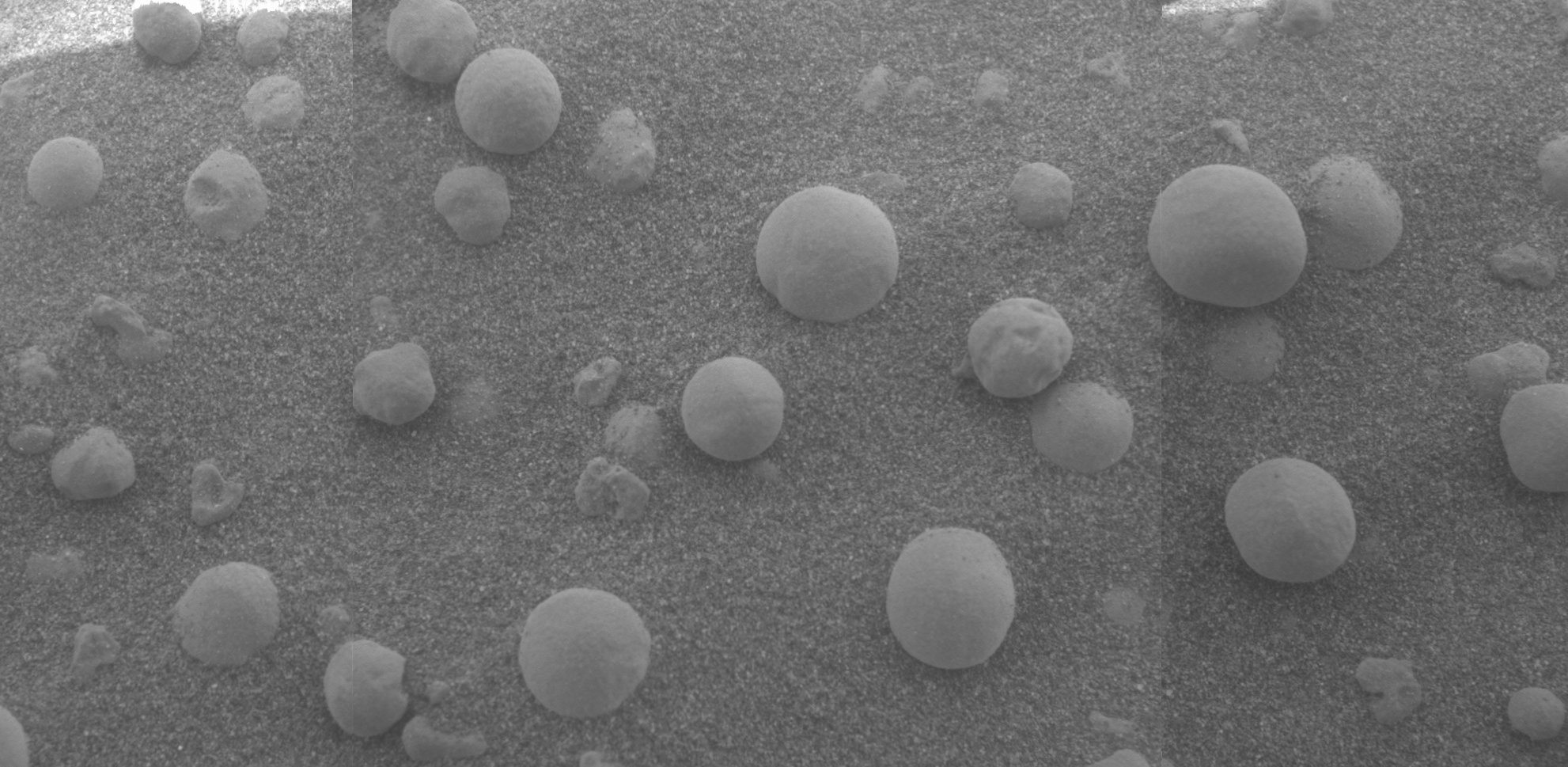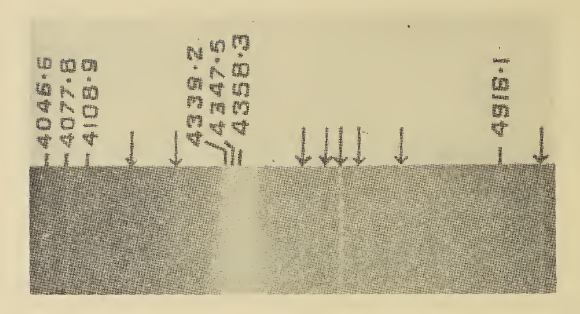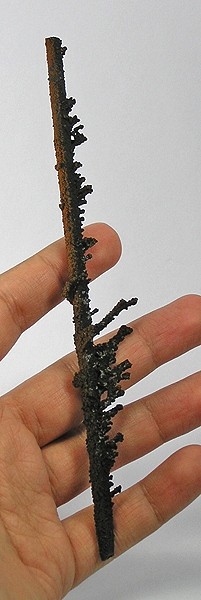|
Chrisstanleyite
Chrisstanleyite, Ag2Pd3Se4, is a selenide mineral that crystallizes in high saline, acidic hydrothermal solution at low temperatures as part of selenide vein inclusions in and alongside calcite veins. It tends to be found in assemblages of other selenides: jagueite, naumannite, fischesserite, oosterboschite, and tiemannite, and it is a solid solution mineral with jagueite Cu2Pd3Se4 in which it shares a unique crystal structure that has not been identified elsewhere (Paar et al. 1998; Nickel 2002; Paar et al. 2004). Chrisstanleyite and jagueite are unlike the other minerals of the selenide family as they do not have a sulfide analogue (Topa et al. 2006). First discovered by Werner Paar from a sample received from Hope's Nose, Torquay, Devon, England, chrisstanleyite has since been discovered in the Pilbara region of Western Australia and in El Chire, La Rioja, Argentina. Chrisstanleyite was named after the Deputy Head and Associate Keeper at the Department of Mineralogy ... [...More Info...] [...Related Items...] OR: [Wikipedia] [Google] [Baidu] |
Selenide Minerals
Selenide minerals are those minerals that have the selenide anion as a main component. Selenides are similar to sulfides and often grouped with them. Examples include: * achavalite * athabascaite * clausthalite * ferroselite * penroseite * stilleite Stilleite is a selenide mineral, zinc selenide, with the formula Zn Se. It has been found only as microscopic gray crystals occurring as inclusions in linnaeite associated with other selenide and sulfides. It was originally discovered in Katan ... * tiemannite * umangite References {{Mineral-stub ... [...More Info...] [...Related Items...] OR: [Wikipedia] [Google] [Baidu] |
Inclusion (mineral)
In mineralogy, an inclusion is any material that is trapped inside a mineral during its formation. In gemology, an inclusion is a characteristic enclosed within a gemstone, or reaching its surface from the interior. According to Hutton's law of inclusions, fragments included in a host rock are older than the host rock itself. Mineralogy Inclusions are usually other minerals or rocks, but may also be water, gas or petroleum. Liquid or vapor inclusions are known as fluid inclusions. In the case of amber it is possible to find insects and plants as inclusions. The analysis of atmospheric gas bubbles as inclusions in ice cores is an important tool in the study of climate change. A xenolith is a pre-existing rock which has been picked up by a lava flow. Melt inclusions form when bits of melt become trapped inside crystals as they form in the melt. Gemology Inclusions are one of the most important factors when it comes to gem valuation. In many gemstones, such as di ... [...More Info...] [...Related Items...] OR: [Wikipedia] [Google] [Baidu] |
Arkose
Arkose () or arkosic sandstone is a detrital sedimentary rock, specifically a type of sandstone containing at least 25% feldspar. Arkosic sand is sand that is similarly rich in feldspar, and thus the potential precursor of arkose. Quartz is commonly the dominant mineral component, and some mica is often present. Apart from the mineral content, rock fragments may also be a significant component. Arkose usually contains small amounts of calcite cement, which causes it to effervesce (fizz) slightly in dilute hydrochloric acid; sometimes the cement also contains iron oxide. Arkose is typically grey to reddish in colour. The sand grains making up an arkose may range from fine to very coarse, but tend toward the coarser end of the scale. Fossils are rare in arkose, due to the depositional processes that form it, although bedding is frequently visible. Arkose is generally formed from the weathering of feldspar-rich igneous or metamorphic, most commonly granitic, rocks, which are p ... [...More Info...] [...Related Items...] OR: [Wikipedia] [Google] [Baidu] |
Hematite
Hematite (), also spelled as haematite, is a common iron oxide compound with the formula, Fe2O3 and is widely found in rocks and soils. Hematite crystals belong to the rhombohedral lattice system which is designated the alpha polymorph of . It has the same crystal structure as corundum () and ilmenite (). With this it forms a complete solid solution at temperatures above . Hematite naturally occurs in black to steel or silver-gray, brown to reddish-brown, or red colors. It is mined as an important ore mineral of iron. It is electrically conductive. Hematite varieties include ''kidney ore'', ''martite'' ( pseudomorphs after magnetite), ''iron rose'' and ''specularite'' ( specular hematite). While these forms vary, they all have a rust-red streak. Hematite is not only harder than pure iron, but also much more brittle. Maghemite is a polymorph of hematite (γ-) with the same chemical formula, but with a spinel structure like magnetite. Large deposits of hematite are ... [...More Info...] [...Related Items...] OR: [Wikipedia] [Google] [Baidu] |
Feldspathic
Feldspars are a group of rock-forming aluminium tectosilicate minerals, also containing other cations such as sodium, calcium, potassium, or barium. The most common members of the feldspar group are the ''plagioclase'' (sodium-calcium) feldspars and the ''alkali'' (potassium-sodium) feldspars. Feldspars make up about 60% of the Earth's crust, and 41% of the Earth's continental crust by weight. Feldspars crystalize from magma as both intrusive and extrusive igneous rocks and are also present in many types of metamorphic rock. Rock formed almost entirely of calcic plagioclase feldspar is known as anorthosite. Feldspars are also found in many types of sedimentary rocks. Compositions The feldspar group of minerals consists of tectosilicates, silicate minerals in which silicon ions are linked by shared oxygen ions to form a three-dimensional network. Compositions of major elements in common feldspars can be expressed in terms of three endmembers: * potassium feldspar (K-spar) en ... [...More Info...] [...Related Items...] OR: [Wikipedia] [Google] [Baidu] |
Raman Spectroscopy
Raman spectroscopy () (named after Indian physicist C. V. Raman) is a spectroscopic technique typically used to determine vibrational modes of molecules, although rotational and other low-frequency modes of systems may also be observed. Raman spectroscopy is commonly used in chemistry to provide a structural fingerprint by which molecules can be identified. Raman spectroscopy relies upon inelastic scattering of photons, known as Raman scattering. A source of monochromatic light, usually from a laser in the visible, near infrared, or near ultraviolet range is used, although X-rays can also be used. The laser light interacts with molecular vibrations, phonons or other excitations in the system, resulting in the energy of the laser photons being shifted up or down. The shift in energy gives information about the vibrational modes in the system. Infrared spectroscopy typically yields similar yet complementary information. Typically, a sample is illuminated with a laser beam ... [...More Info...] [...Related Items...] OR: [Wikipedia] [Google] [Baidu] |
Umangite
Umangite is a copper selenide mineral, Cu3 Se2, discovered in 1891. It occurs only in small grains or fine granular aggregates with other copper minerals of the sulfide group. It has a hardness of 3. It is blue-black to red-violet in color with a black streak. It has a metallic luster. Umangite is named after the locality of Sierra de Umango, La Rioja province in Argentina. It also occurs at other localities including the Harz Mountains in Germany, and at Skrickerum, Sweden. See also *List of minerals This is a list of minerals for which there are articles on Wikipedia. Minerals are distinguished by various chemical and physical properties. Differences in chemical composition and crystal structure distinguish the various ''species''. Within a m ... References Copper(I,II) minerals Selenide minerals Tetragonal minerals Minerals in space group 113 {{mineral-stub ... [...More Info...] [...Related Items...] OR: [Wikipedia] [Google] [Baidu] |
Berzelianite
Berzelianite is a rare copper selenide mineral with the formula Cu2 Se. It occurs as thin dendritic crusts or as fine-grained inclusions. It crystallizes in the isometric system, unlike its dimorph, bellidoite, which crystallizes in the tetragonal system. The crystals are opaque and slightly malleable. Occurrence and name Berzelianite was first identified at the Skrikerum Mine (also spelled as Skrickerum Mine) in Valdemarsvik, Östergötland, Sweden in 1850. It was named by James Dwight Dana to honor Jöns Jakob Berzelius, a Swedish chemist who is seen as the father of analytical chemistry. He invented chemical symbol notation and discovered the elements cerium, selenium, silicon, and thorium. Berzelianite often occurs together with eucairite, clausthalite, tiemannite, umangite, klockmannite, aguilarite, crookesite, athabascaite, stromeyerite, polybasite, pearceite, gold, uraninite, pyrite, marcasite, calcite. See also * List of minerals * List of minerals named a ... [...More Info...] [...Related Items...] OR: [Wikipedia] [Google] [Baidu] |
Goethite
Goethite (, ) is a mineral of the diaspore group, consisting of iron(III) oxide-hydroxide, specifically the "α" polymorph. It is found in soil and other low-temperature environments such as sediment. Goethite has been well known since ancient times for its use as a pigment (brown ochre). Evidence has been found of its use in paint pigment samples taken from the caves of Lascaux in France. It was first described in 1806 based on samples found in the Hollertszug Mine in Herdorf, Germany. The mineral was named after the German polymath and poet Johann Wolfgang von Goethe (1749–1832). Composition Goethite is an iron oxyhydroxide containing ferric iron. It is the main component of rust and bog iron ore. Goethite's hardness ranges from 5.0 to 5.5 on the Mohs Scale, and its specific gravity varies from 3.3 to 4.3. The mineral forms prismatic needle-like crystals ("needle ironstone") but is more typically massive. Feroxyhyte and lepidocrocite are both polymorphs of the ... [...More Info...] [...Related Items...] OR: [Wikipedia] [Google] [Baidu] |
Quartz
Quartz is a hard, crystalline mineral composed of silica ( silicon dioxide). The atoms are linked in a continuous framework of SiO4 silicon-oxygen tetrahedra, with each oxygen being shared between two tetrahedra, giving an overall chemical formula of SiO2. Quartz is the second most abundant mineral in Earth's continental crust, behind feldspar. Quartz exists in two forms, the normal α-quartz and the high-temperature β-quartz, both of which are chiral. The transformation from α-quartz to β-quartz takes place abruptly at . Since the transformation is accompanied by a significant change in volume, it can easily induce microfracturing of ceramics or rocks passing through this temperature threshold. There are many different varieties of quartz, several of which are classified as gemstones. Since antiquity, varieties of quartz have been the most commonly used minerals in the making of jewelry and hardstone carvings, especially in Eurasia. Quartz is the mineral definin ... [...More Info...] [...Related Items...] OR: [Wikipedia] [Google] [Baidu] |
Malachite
Malachite is a copper carbonate hydroxide mineral, with the formula Cu2CO3(OH)2. This opaque, green-banded mineral crystallizes in the monoclinic crystal system, and most often forms botryoidal, fibrous, or stalagmitic masses, in fractures and deep, underground spaces, where the water table and hydrothermal fluids provide the means for chemical precipitation. Individual crystals are rare, but occur as slender to acicular prisms. Pseudomorphs after more tabular or blocky azurite crystals also occur. Etymology and history The stone's name derives (via la, molochītis, frm, melochite, and Middle English ''melochites'') from Greek Μολοχίτης λίθος ''molochites lithos'', "mallow-green stone", from μολόχη ''molochē'', variant of μαλάχη ''malāchē'', "mallow". The mineral was given this name due to its resemblance to the leaves of the mallow plant. Malachite was mined from deposits near the Isthmus of Suez and the Sinai as early as 4000 BCE. ... [...More Info...] [...Related Items...] OR: [Wikipedia] [Google] [Baidu] |





